White Paper on Adaptive Situational Awareness Enhancing Augmented Reality Interface Design on First Responders in Rescue Tasks
Abstract
:1. Introduction
2. Survey to Collect Information Prioritization Requirements According to Operation Modes and User Profiles
2.1. Population
2.2. First Responders and Operation Type Description
- Firefighter: The main task of a firefighter is to control and extinguish fires occurring in settings such as residential, commercial, and wild-land areas. Frequent circumstances in these operations include combustible materials, with major risks including smoke, oxygen deficiency, elevated temperatures, poisonous atmospheres, and violent air flows, creating toxic and dangerous environments [27].
- Search and Rescue: They coordinate efforts to locate and assist persons, vehicles, other conveyances, or buildings considered in imminent danger. Participation in these tasks requires prior training and knowledge of the use of appropriate resources to locate persons in distress and provide them with the necessary assistance, including initial medical care, to ensure their safety and well-being.
- Natural Disasters: The main task of these FRs is to provide assistance in natural disaster situations such as forest fires, floods, extreme snowstorms, landslides, earthquakes or hurricanes. This assistance takes the form of evacuation tasks, search and rescue operations, and health care, among others.
- Emergency Medical Services (EMS): They provide urgent pre-hospital treatment and stabilization for serious illnesses and injuries that occur in accidental circumstances. In some situations, the transport of injured victims is the next point of care, typically to an emergency department of a hospital.
- Hazardous Materials (Hazmat) Incidents: Mishaps occurring as a result of the release or spillage of hazardous materials involve a high risk to public health and the environment, given the toxicity or radioactivity of the scenario produced by the chemicals, gases or radioactive substances released. The FRs trained to assist in these rescue tasks have the objective of controlling and decontaminating the hazardous materials as well as managing the relevant health care.
- Survival: In this scenario, the survival of the First Responder (FR) is prioritized, so the amount of information exposed at the interface is minimum quantity to avoid overwhelming the FR with unnecessary information details and focus on what is essential for survival. The main purpose of this information is to facilitate the FR’s immediate exit from the scenario.
- Search: This scenario is characterized by the fact that the additional information facilitates the search for victims within a rescue scenario. As this is an a priori activity, the amount of information provided is of a medium level.
- Complete: This scenario differs from the previous scenarios in that it is a non-threatening situation, where the FR is fully capable of receiving complete mission status information. That is, it is considered the maximum amount of information that an FR can receive in a rescue scenario.
2.3. Smart Helmet and Display Interface
2.4. Survey
- 1.
- How frequently should the following information appear?
- 1 = Never, 2 = Only if there is anomaly info, 3 = Constantly
- 2.
- What is the maximum number of functionalities visible at one time?
- Select a number between 1–13. Max number = _____________
- 3.
- What is the priority order of the functionalities to be shown?
- Order from 1 to Max number for the following list of functionalities.
- 4.
- What else would you add, remove or change?
- Include biosignals of paired FR, or the level of the oxygen tank.
3. Results
3.1. Survival
3.2. Rescue
3.3. Complete
4. Discussion
5. Conclusions
Author Contributions
Funding
Institutional Review Board Statement
Informed Consent Statement
Data Availability Statement
Acknowledgments
Conflicts of Interest
Abbreviations
| FR | First Responder |
| C2 | control center |
| EMS | Emergency and Medical System |
| F | firefighter |
| ND | Natural Disaster |
| SR | Search and Rescue |
| HI | Hazmat Incident |
Appendix A. Participant Details
| Acronym | Institution | Country | Number of Participants |
|---|---|---|---|
| ARC | Österreichisches Rotes Kreuz | Austria | 3 |
| ENSOSP | École Nationale Supérieure des Officiers de Sapeurs-Pompiers | France | 1 |
| FME | Federación Madrileña de Espeleología | Spain | 1 |
| GERA | Grupo Especial de Rescate en Altura | Spain | 10 |
| ISEMI | ISEM-Institut pre Medzinárodnú Bezpečnosť a Krízové Riadanie | Slovakia | 1 |
| SDIS | Service Départemental Incendie et Secours de la Savoie | France | 2 |
| SUMMA 112 | Servicio de Urgencias Médicas de Madrid | Spain | 12 |
| UME | Unidad Militar de Emergencias | Spain | 3 |
| Type of Mission | Number of Participants |
|---|---|
| Emergency and Medical System | 15 |
| Firefighter | 1 |
| Firefighter, Search Rescue | 2 |
| Firefighter, Search and Rescue, Hazmat Incidents | 1 |
| Firefighter, Search and Rescue, Natural Disasters | 10 |
| Hazmat Incidents | 1 |
| Search and Rescue | 1 |
| Search and Rescue, Emergency and Medical System | 1 |
| Search and Rescue, Emergency and Medical System, Natural Disasters | 1 |
Appendix B. Awareness Enhancing Module Symbols
| Situational Awareness Enhancing MODULES | Description of Corresponding Sensors |
|---|---|
 | Biosignals: Description of the biological signals of the FR. The color of the icons will change from green to red depending on if the values received are good or bad. |
 Heart rate: Measure of the heartbeat per minute. Heart rate: Measure of the heartbeat per minute. | |
 Breath rate: Number of breaths per minute. Breath rate: Number of breaths per minute. | |
 | Black Box: The black box is a device that has some environmental sensors inside: temperature, humidity and number of people around it. |
 Temperature: Temperature from the environment around the black box. Temperature: Temperature from the environment around the black box. | |
 humidity: Humidity of the environment around the black box. humidity: Humidity of the environment around the black box. | |
 People: Number of people currently surrounding the black box. People: Number of people currently surrounding the black box. | |
 | Ad hoc network: Information of the wireless network generated by the gateways that each FR carries during an operation. It provides information about the battery level of the gateway and the status of communications between the control center (C2) and other FRs. |
 Battery level: battery level of the gateway that both connects and is part of the generated network. The image is updated depending on the amount of battery left Battery level: battery level of the gateway that both connects and is part of the generated network. The image is updated depending on the amount of battery left | |
 C2 connection: Flag showing if the control center is reachable through the ad hoc network. If so, the C2 could send coordinates of points of interest or modify the view on the Interface C2 connection: Flag showing if the control center is reachable through the ad hoc network. If so, the C2 could send coordinates of points of interest or modify the view on the Interface | |
 FR connections: Number of FRs reachable within the ad hoc network. FR connections: Number of FRs reachable within the ad hoc network. | |
 | Augmented olfaction tool: It provides the concentration values on up to 5 types of gases, turning from green to yellow to red depending on if the gas levels are dangerous or not. |
 | Signs of life: This tools provides information if it detects life (through walls for example); it provides an estimated value of the distance to the found individual. |
 | Radar: This device shows the amount of objects that are approaching the FR. The interface blinks when an object is approaching |
 | Wireless finder: This device measures the distance to devices that produce wireless signals such as Bluetooth or Wi-Fi, which usually come from mobile phones from victims under the rubble. The interface guides the FR in the initial calibration phase also. |
 | Robust vision: Displays the type and amount of objects detected by the object-detection module. It can be switched to a full camera view that will show the IR video feed with the red squares instead of the transparent view. |
Appendix C. Survey Example
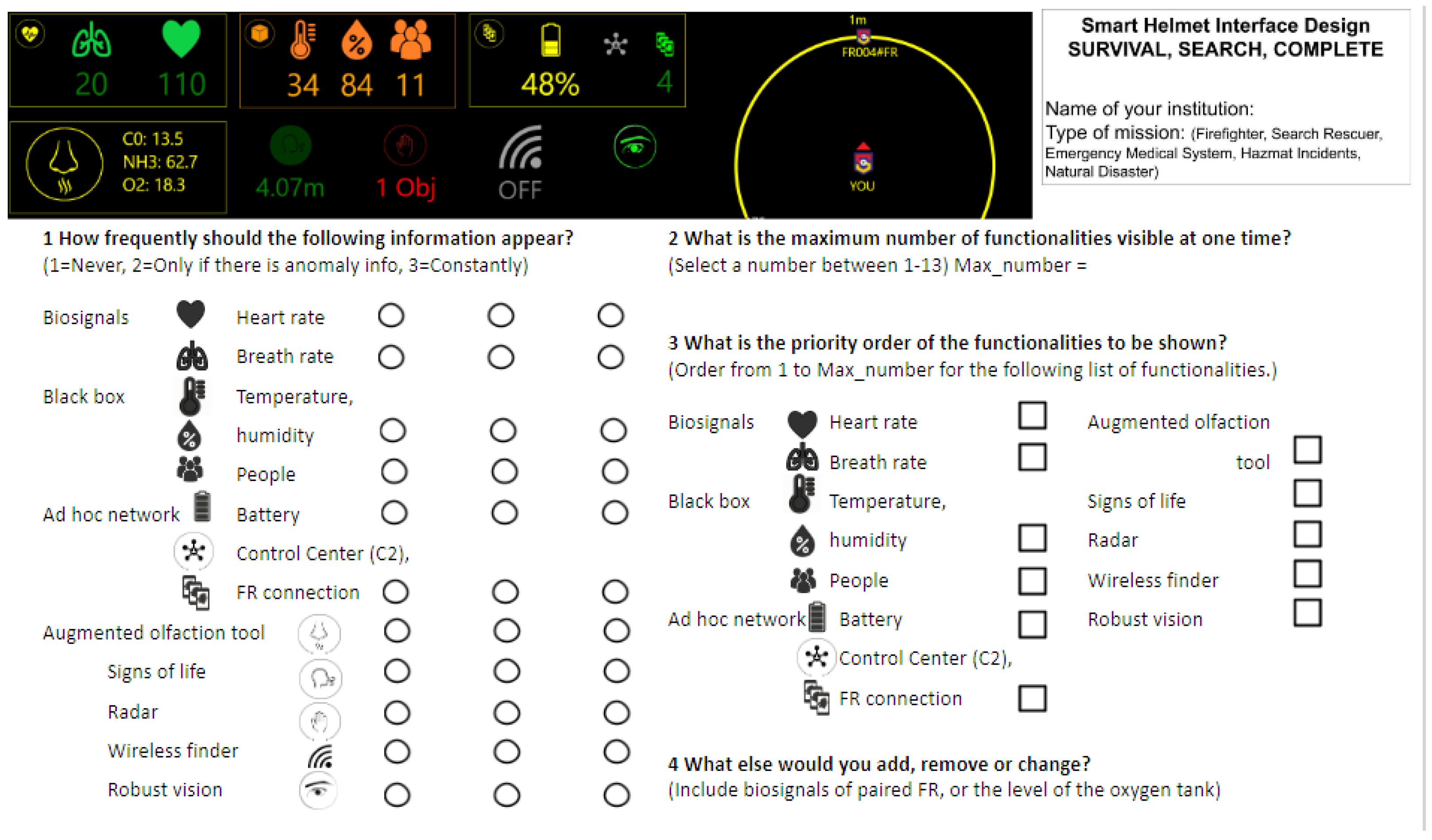
References
- Nunes, I.L.; Lucas, R.; Simões-Marques, M.; Correia, N. Augmented reality in support of disaster response. In Advances in Human Factors and Systems Interaction: Proceedings of the AHFE 2017 International Conference on Human Factors and Systems Interaction, Los Angeles, CA, USA, 17– 21 July 2017; Springer: Berlin/Heidelberg, Germany, 2018; pp. 155–167. [Google Scholar]
- Koutitas, G.; Smith, K.S.; Lawrence, G.; Metsis, V.; Stamper, C.; Trahan, M.; Lehr, T. A virtual and augmented reality platform for the training of first responders of the ambulance bus. In Proceedings of the 12th ACM International Conference on Pervasive Technologies Related to Assistive Environments, Melbourne, Australia, 11–15 February 2019; pp. 299–302. [Google Scholar]
- Koutitas, G.; Smith, S.; Lawrence, G. Performance evaluation of AR/VR training technologies for EMS first responders. Virtual Real. 2021, 25, 83–94. [Google Scholar] [CrossRef]
- Kapalo, K.A.; Bockelman, P.; LaViola, J.J., Jr. “Sizing Up” Emerging Technology for Firefighting: Augmented Reality for Incident Assessment. In Proceedings of the Human Factors and Ergonomics Society Annual Meeting; SAGE Publications: Los Angeles, CA, USA, 2018; Volume 62, pp. 1464–1468. [Google Scholar]
- Arregui, H.; Irigoyen, E.; Cejudo, I.; Simonsen, S.; Ribar, D.; Kourtis, M.A.; Spyridis, Y.; Stathakarou, N.; Batistatos, M.C. An Augmented Reality Framework for First Responders: The RESPOND-A project approach. In Proceedings of the Panhellenic Conference on Electronics & Telecommunications (PACET), Tripolis, Greece, 2–3 December 2022; pp. 1–6. [Google Scholar]
- Neustaedter, C.; McGee, J.; Dash, P. Sharing 9-1-1 video call information between dispatchers and firefighters during everyday emergencies. In Proceedings of the 2019 on Designing Interactive Systems Conference, San Diego, CA, USA, 23–28 June 2019; pp. 567–580. [Google Scholar]
- Dimou, A.; Kogias, D.G.; Trakadas, P.; Perossini, F.; Weller, M.; Balet, O.; Patrikakis, C.Z.; Zahariadis, T.; Daras, P. FASTER: First Responder Advanced Technologies for Safe and Efficient Emergency Response. In Technology Development for Security Practitioners; Springer: Berlin/Heidelberg, Germany, 2021; pp. 447–460. [Google Scholar]
- Morenilla Rodriguez, R.M.; Cintora Sanz, A.M. FASTER Project: First responder Advanced technologies for Safe and efficient Emergency Response. Int. J. Integr. Care (IJIC) 2022, 22. [Google Scholar] [CrossRef]
- Fernández García, A.; Oregui, X.; Lingos, K.; Konstantoudakis, K.; Belmonte Hernández, A.; Azpiroz, I.; Zarpalas, D. Smart Helmet: Combining sensors, AI, Augmented Reality and personal protection to enhance first responders’ situational awareness. Zenodo 2023, 25, 45–53. [Google Scholar] [CrossRef]
- Oregui, X.; Azpiroz, I.; Ruiz, V.; Larraga, B.; Gutiérrez, Á.; Olaizola, I.G. Modular Multi-Platform Interface to Enhance the Situational Awareness of the First Responders. ISCRAM Proc. 2024, 21. Available online: https://ojs.iscram.org/index.php/Proceedings/article/view/88 (accessed on 2 September 2024).
- RESCUER. First RESponder-Centered Support Toolkit for Operating in Adverse and InfrastrUcture-Less EnviRonments. Funding Received from the European Union’s Horizon 2020 Research & Innovation Programme under Grant Agreement No. 101021836. RESCUER Consortium. 2024. Available online: https://rescuerproject.eu (accessed on 2 September 2024).
- Grigoriou, E.; Fountoulakis, M.; Kafetzakis, E.; Giannoulakis, I.; Fountoukidis, E.; Karypidis, P.A.; Margounakis, D.; Mikelidou, C.V.; Sennekis, I.; Boustras, G. Towards the RESPOND-A initiative: Next-generation equipment tools and mission-critical strategies for First Responders. In Proceedings of the 2022 IEEE International Conference on Omni-layer Intelligent Systems (COINS), Barcelona, Spain, 1–3 August 2022; pp. 1–5. [Google Scholar]
- IFAFRI. International Forum to Advance First Responder Innovation (IFAFRI). Available online: https://www.internationalresponderforum.org/services/capability-gaps (accessed on 2 September 2024).
- Ludwig, T.; Reuter, C.; Pipek, V. What you see is what I need: Mobile reporting practices in emergencies. In Proceedings of the ECSCW 2013: Proceedings of the 13th European Conference on Computer Supported Cooperative Work, Paphos, Cyprus, 21–25 September 2013; Springer: Berlin/Heidelberg, Germany, 2013; pp. 181–206. [Google Scholar]
- Baseman, J.; Revere, D.; Painter, I.; Stangenes, S.; Lilly, M.; Beaton, R.; Calhoun, R.; Meischke, H. Impact of new technologies on stress, attrition and well-being in emergency call centers: The NextGeneration 9–1-1 study protocol. BMC Public Health 2018, 18, 597. [Google Scholar] [CrossRef] [PubMed]
- Camp, P.J.; Hudson, J.M.; Keldorph, R.B.; Lewis, S.; Mynatt, E.D. Supporting communication and collaboration practices in safety-critical situations. In Proceedings of the CHI’00 Extended Abstracts on Human Factors in Computing Systems, The Hague, The Netherlands, 1–6 April 2000; pp. 249–250. [Google Scholar]
- Longo, L.; Wickens, C.D.; Hancock, G.; Hancock, P.A. Human mental workload: A survey and a novel inclusive definition. Front. Psychol. 2022, 13, 883321. [Google Scholar] [CrossRef] [PubMed]
- Reimer, B.; Mehler, B. The impact of cognitive workload on physiological arousal in young adult drivers: A field study and simulation validation. Ergonomics 2011, 54, 932–942. [Google Scholar] [CrossRef] [PubMed]
- Fruhling, A.; Reisher, E. Assessing decision makers’cognitive load for a first responder health monitoring system. SAIS 2022 Proc. 2022, 30. Available online: https://aisel.aisnet.org/sais2022/30 (accessed on 2 September 2024).
- Gutiérrez, A.; Blanco, P.; Ruiz, V.; Chatzigeorgiou, C.; Oregui, X.; Álvarez, M.; Navarro, S.; Feidakis, M.; Azpiroz, I.; Izquierdo, G.; et al. Biosignals Monitoring of First Responders for Cognitive Load Estimation in Real-Time Operation. Appl. Sci. 2023, 13, 7368. [Google Scholar] [CrossRef]
- Haller, M.; Billinghurst, M.; Thomas, B. Emerging Technologies of Augmented Reality: Interfaces and Design: Interfaces and Design; Igi Global: Hershey, PA, USA, 2006. [Google Scholar]
- Pfeuffer, K.; Abdrabou, Y.; Esteves, A.; Rivu, R.; Abdelrahman, Y.; Meitner, S.; Saadi, A.; Alt, F. ARtention: A design space for gaze-adaptive user interfaces in augmented reality. Comput. Graph. 2021, 95, 1–12. [Google Scholar] [CrossRef]
- United States. Substance Abuse and Mental Health Services Administration First Responders: Behavioral Health Concerns, Emergency Response, and Trauma. Disaster Technical Assistance Center Supplemental Research Bulletin. 2018. Available online: https://archive.hshsl.umaryland.edu/handle/10713/14980 (accessed on 2 September 2024).
- Emergency Response Framework (ERF); World Health Organization: Geneva, Switzwerland, 2017; Available online: https://iris.who.int/bitstream/handle/10665/258604/9789241512299-eng.pdf (accessed on 2 September 2024).
- Nerín, M.A.; Soteras, I.; Sanz, I.; Egea, P. The “medicalization” of mountain rescue teams: A social and economic approach based on mortality evolution in the central Pyrenees. Arch. Med. Deporte 2019, 35, 393–401. [Google Scholar]
- Ezeizabarrena, X. Mountains, Risk And Liability: A Brief Legal Approach. Rev. Int. Estud. Vascos (RIEV) 2016, 61, 193–211. Available online: https://www.eusko-ikaskuntza.eus/PDFAnlt/riev/61/RIEV%2061_1_193-211.pdf (accessed on 2 September 2024).
- MacDermid, J.C.; Lomotan, M.; Hu, M.A. Canadian career firefighters’ mental health impacts and priorities. Int. J. Environ. Res. Public Health 2021, 18, 12666. [Google Scholar] [CrossRef] [PubMed]

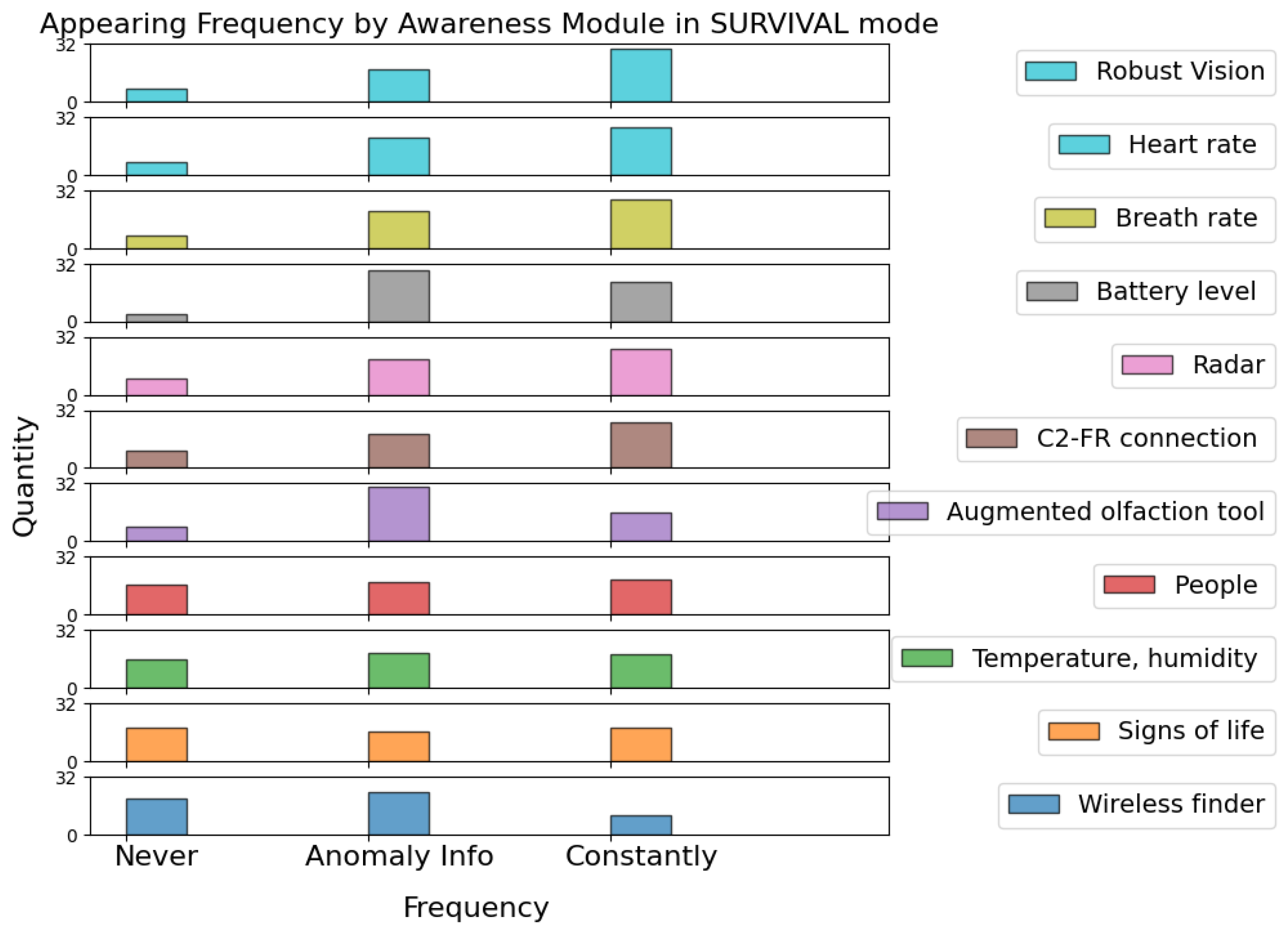
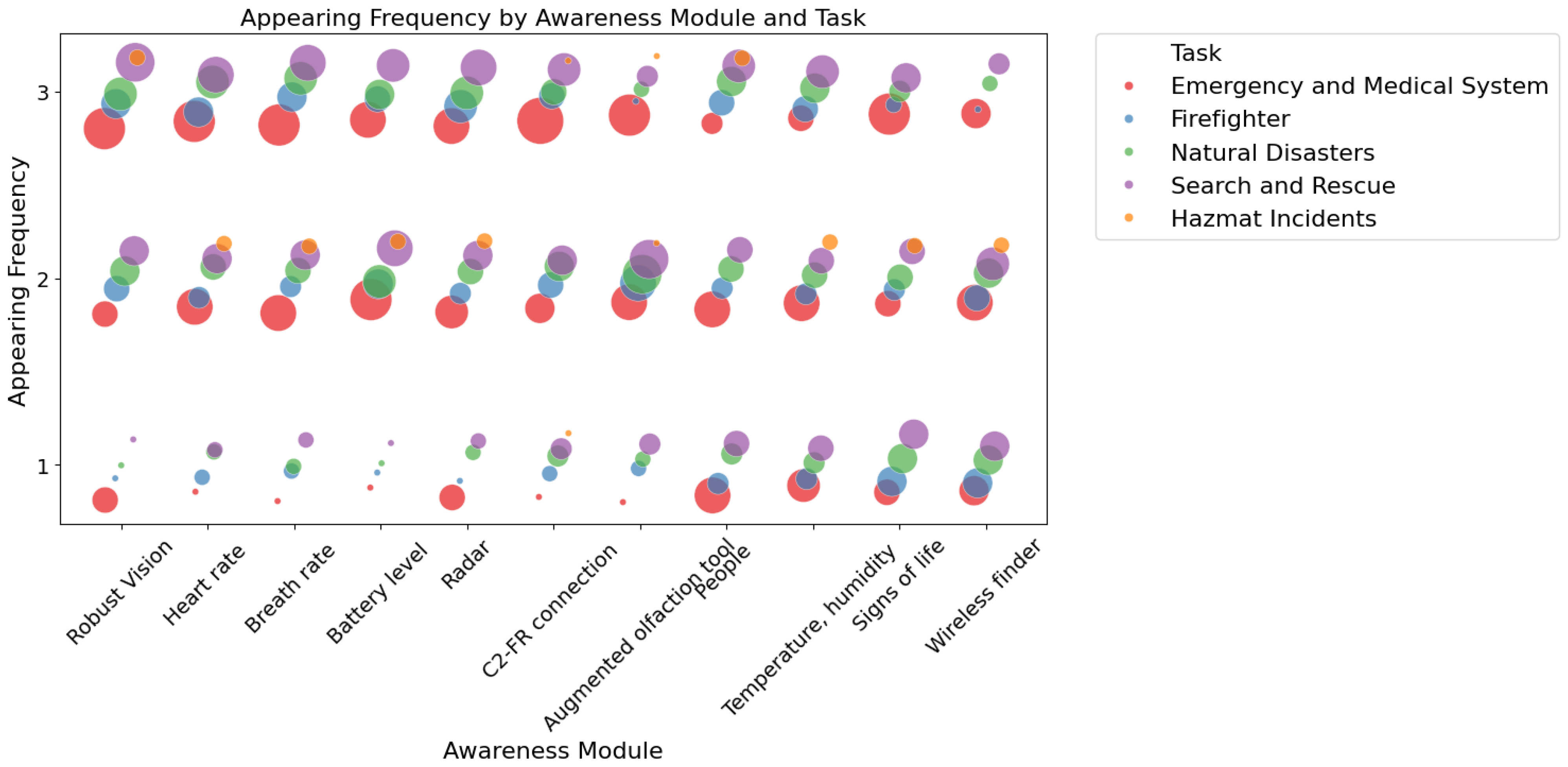
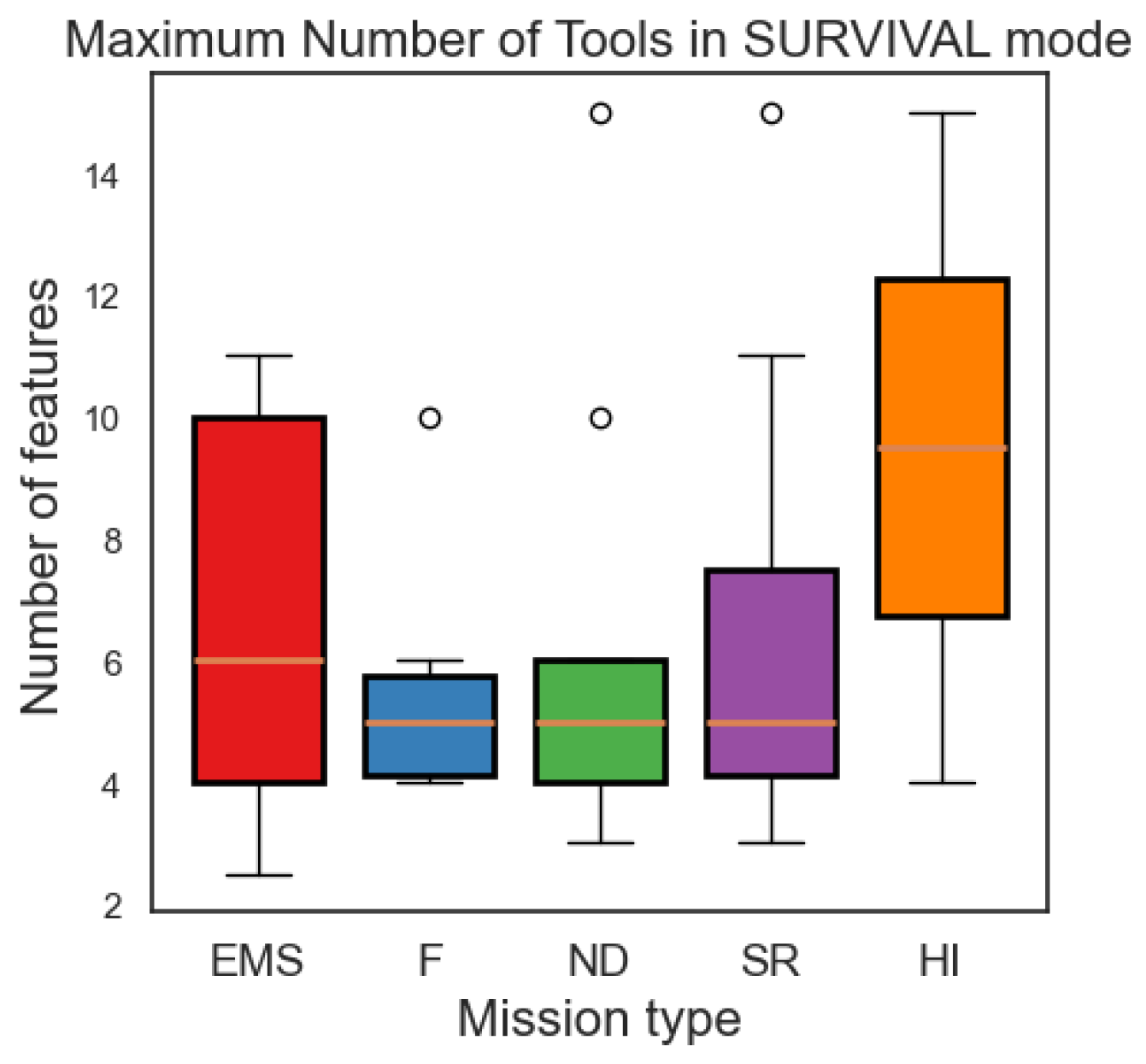

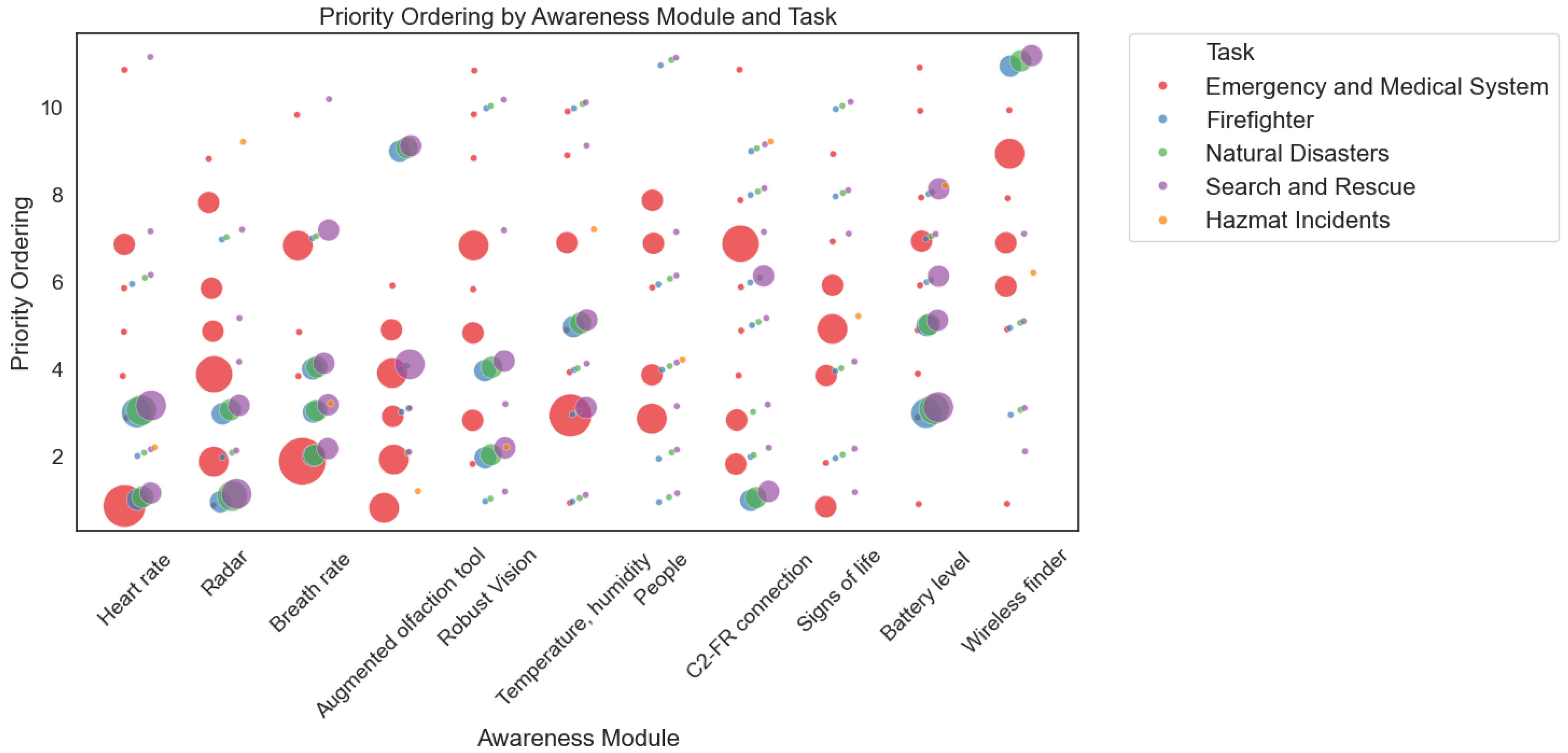
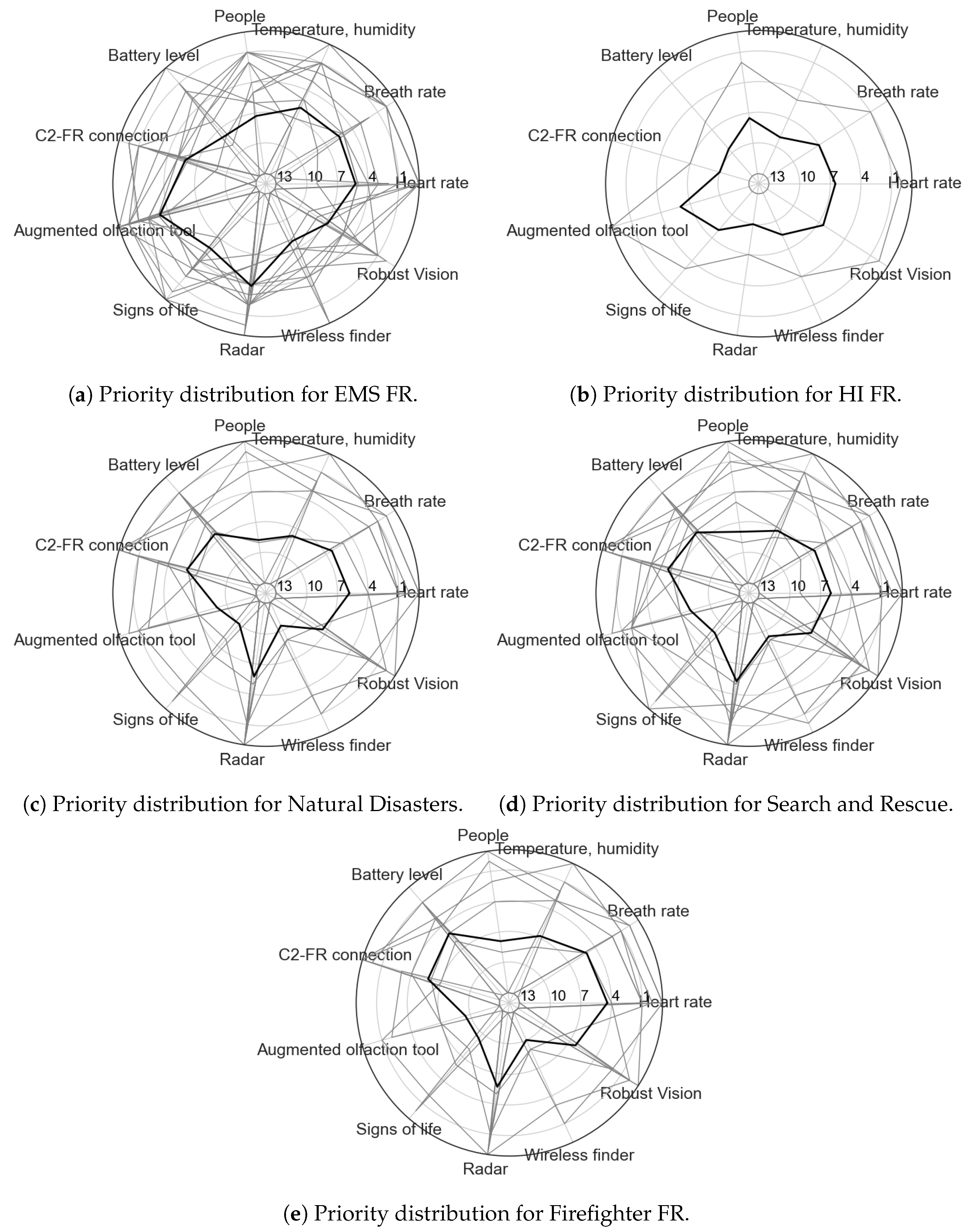
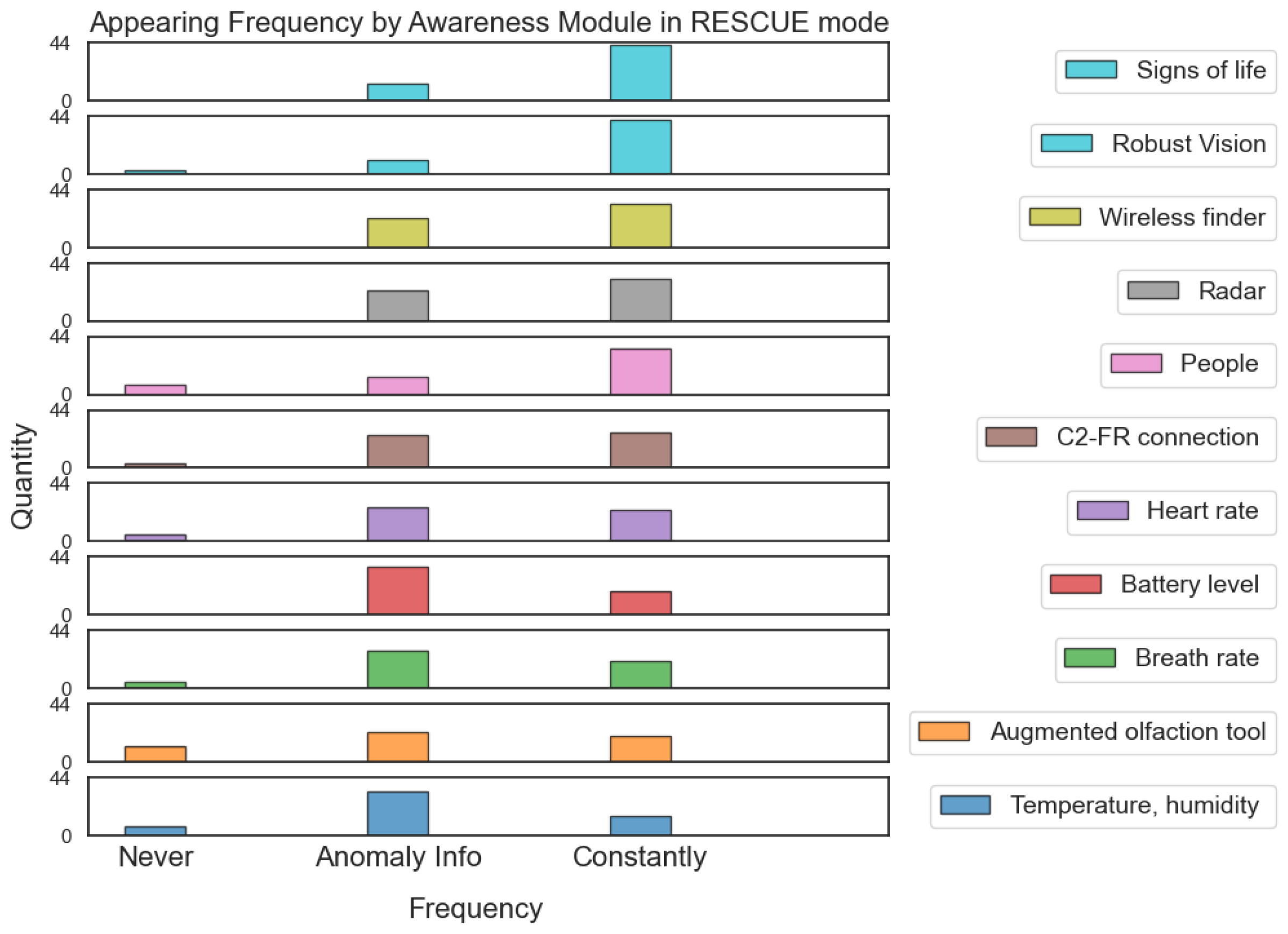
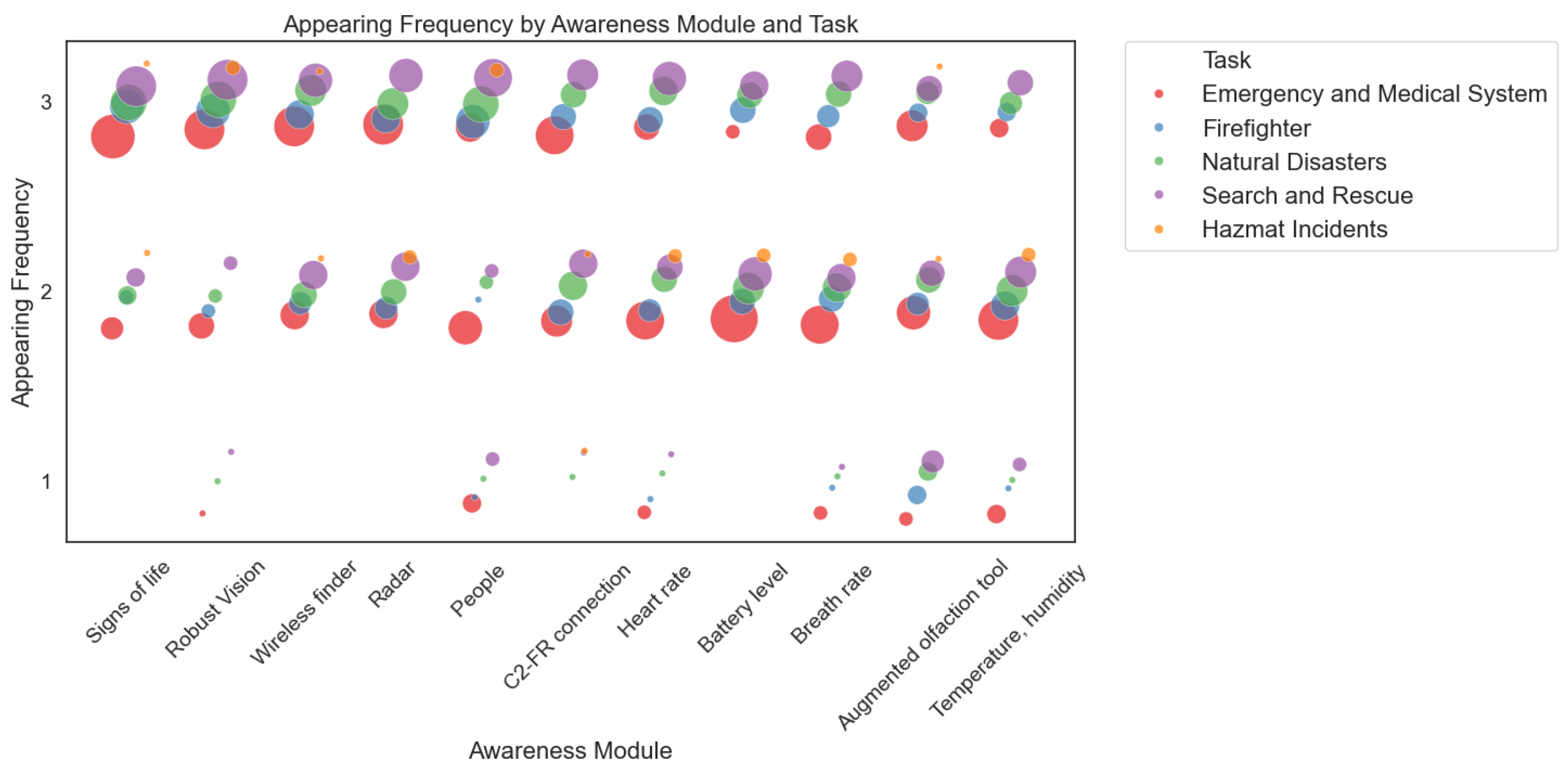

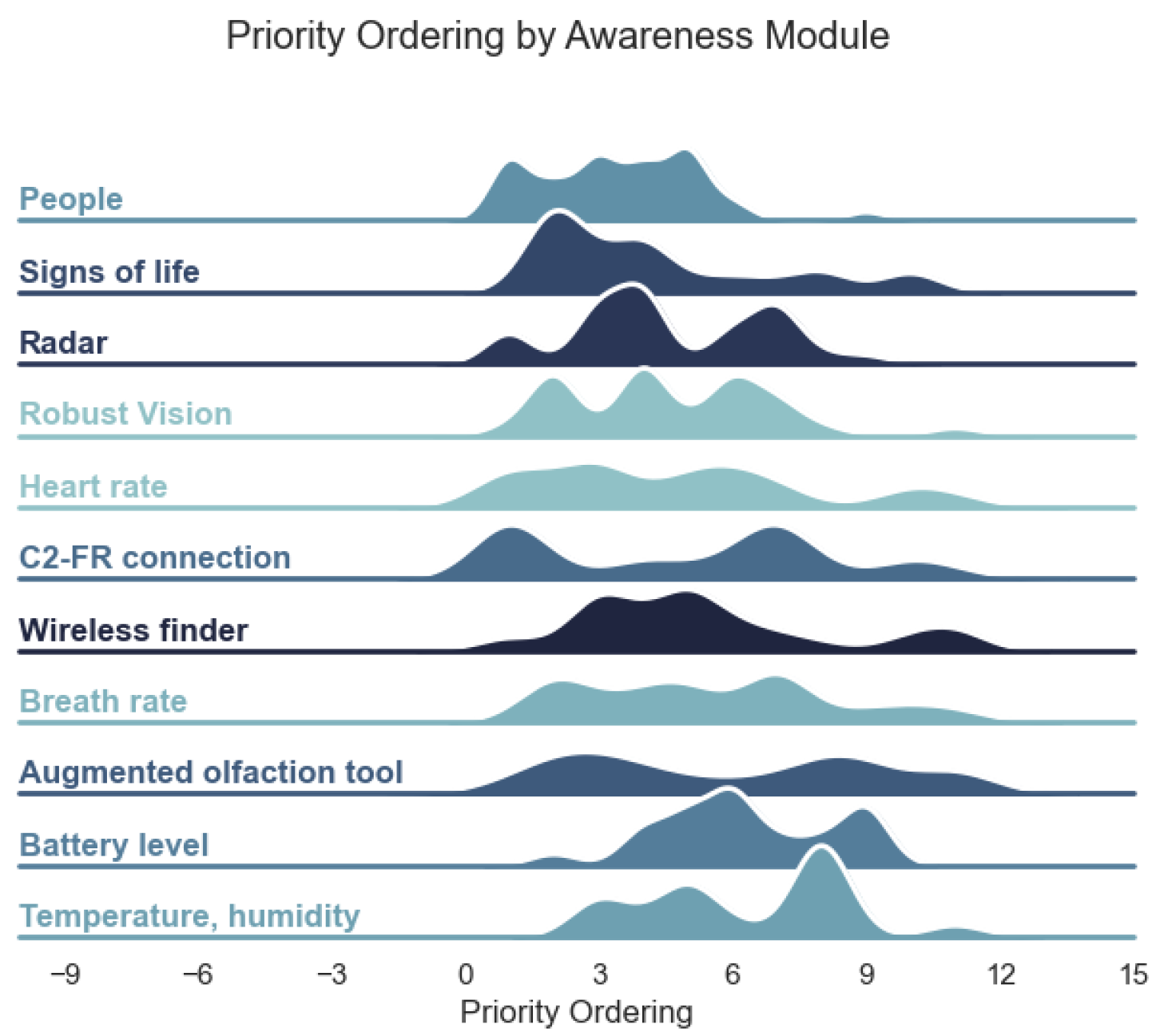
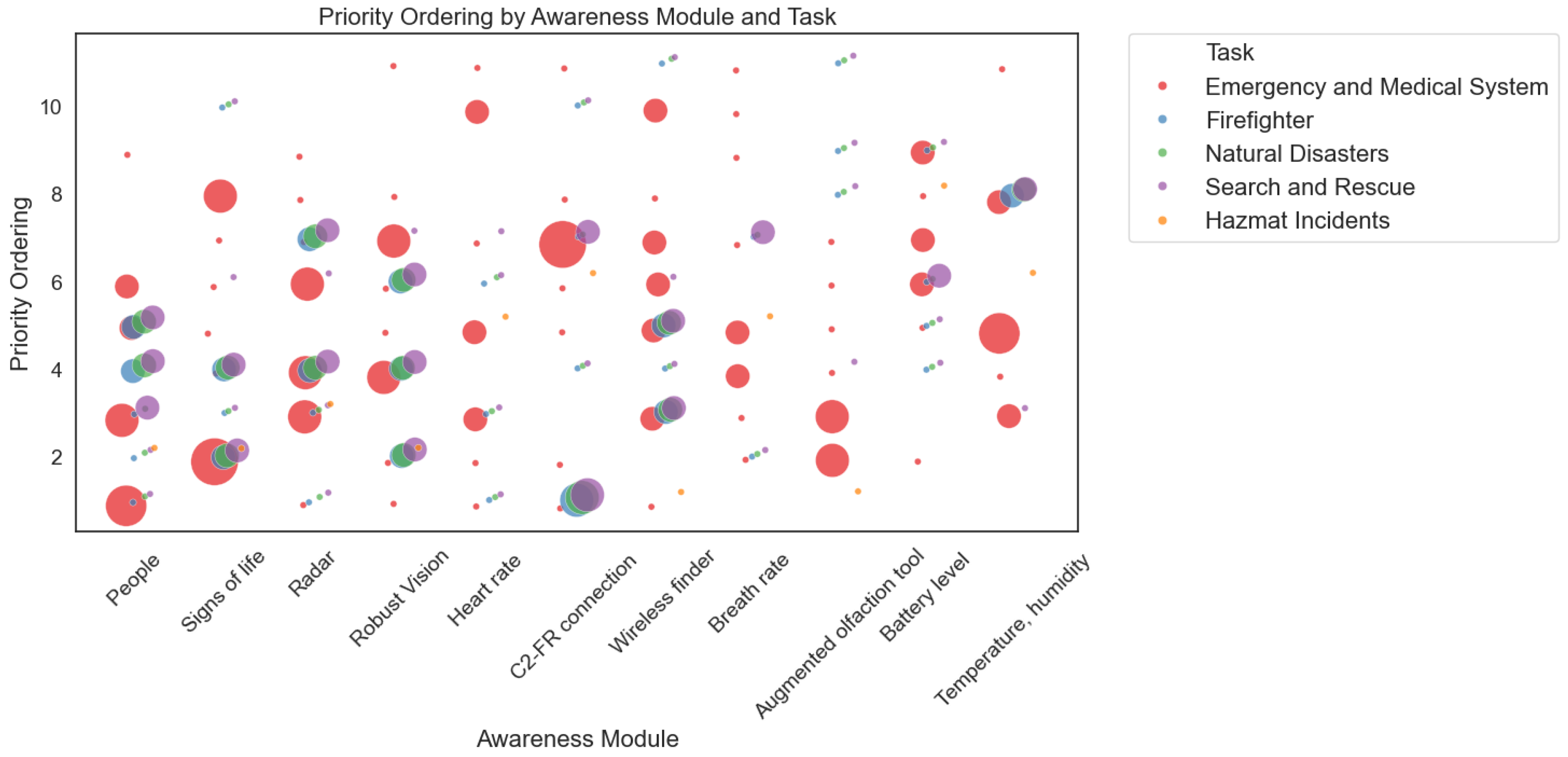

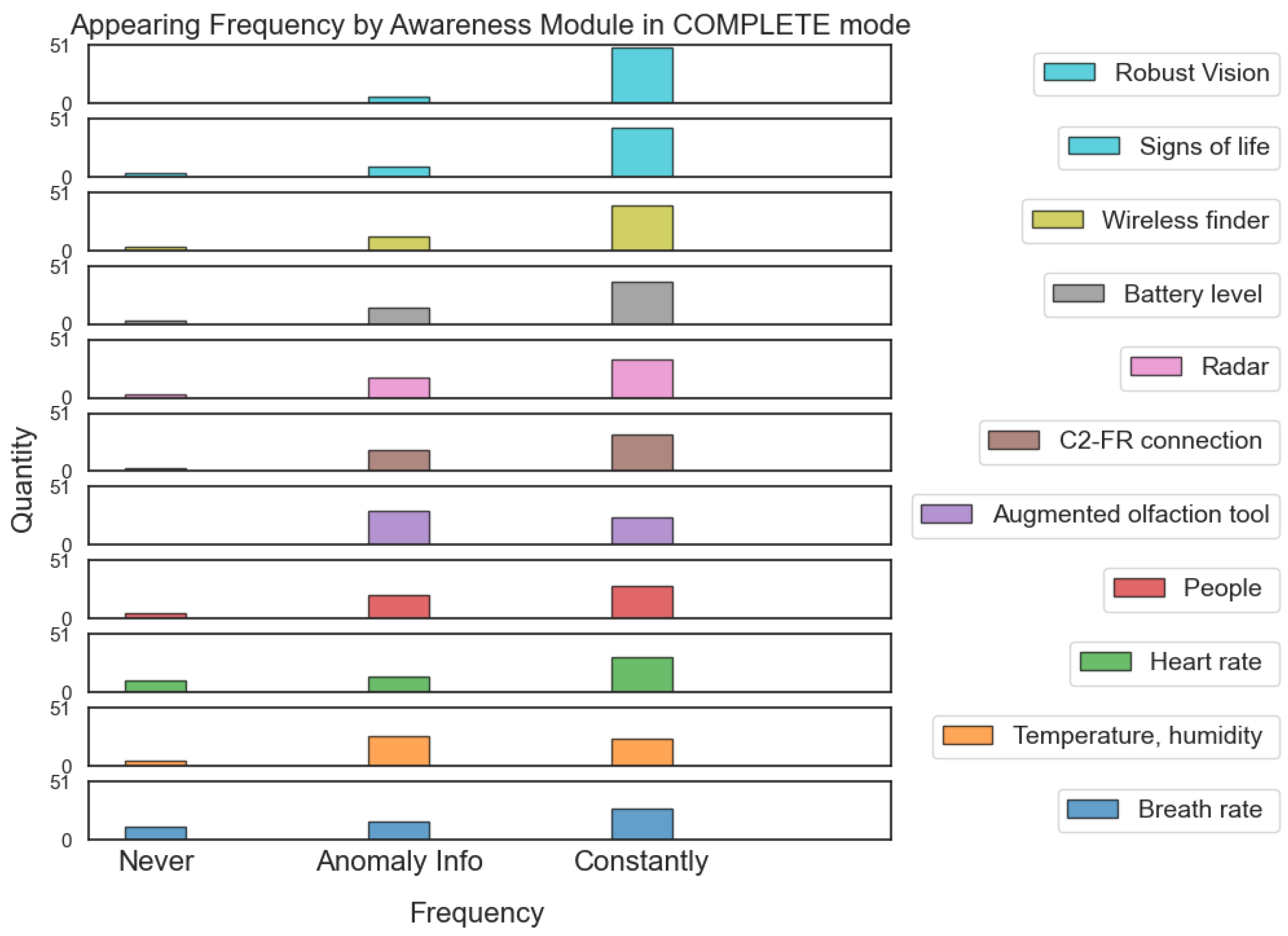
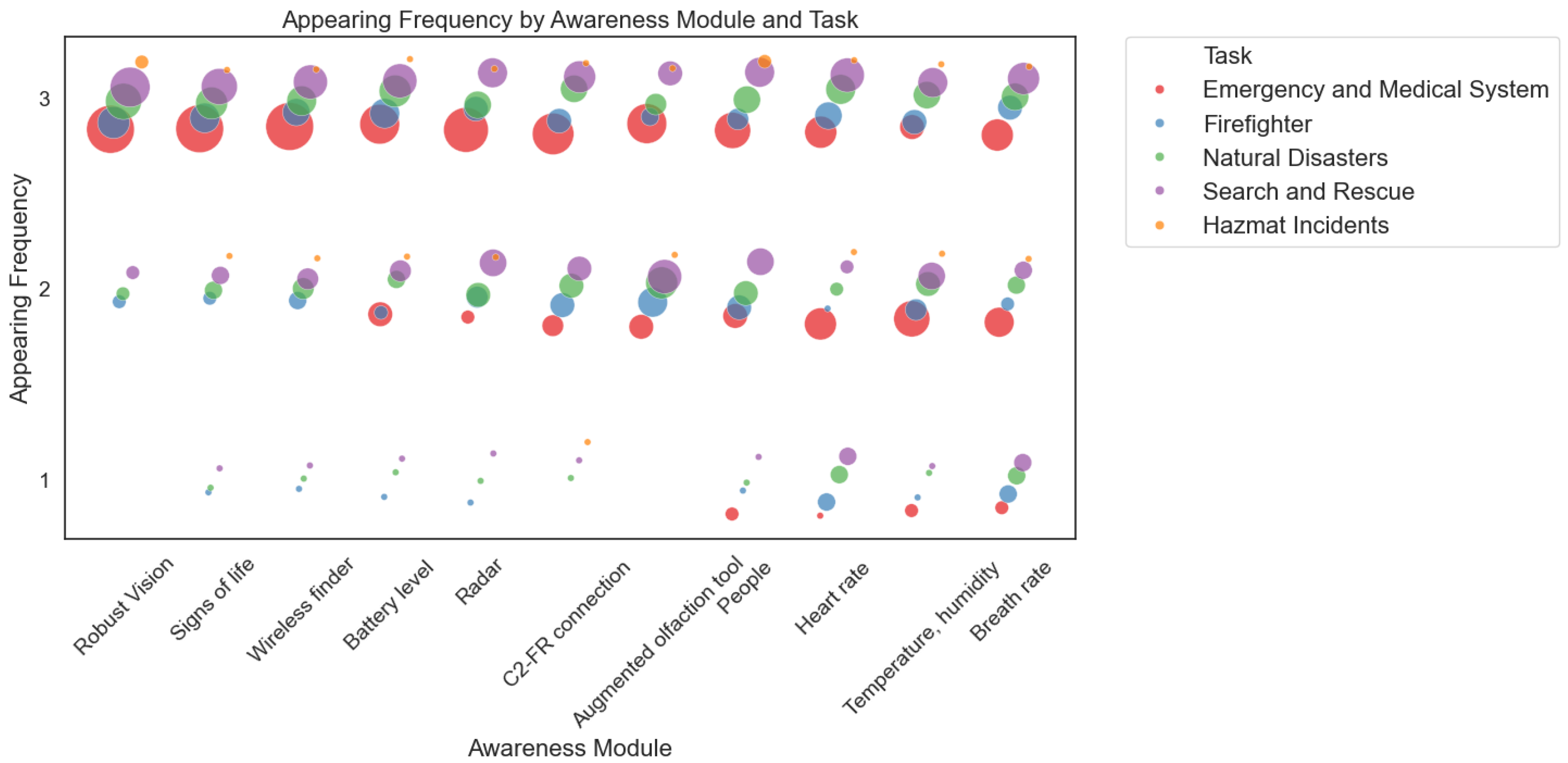
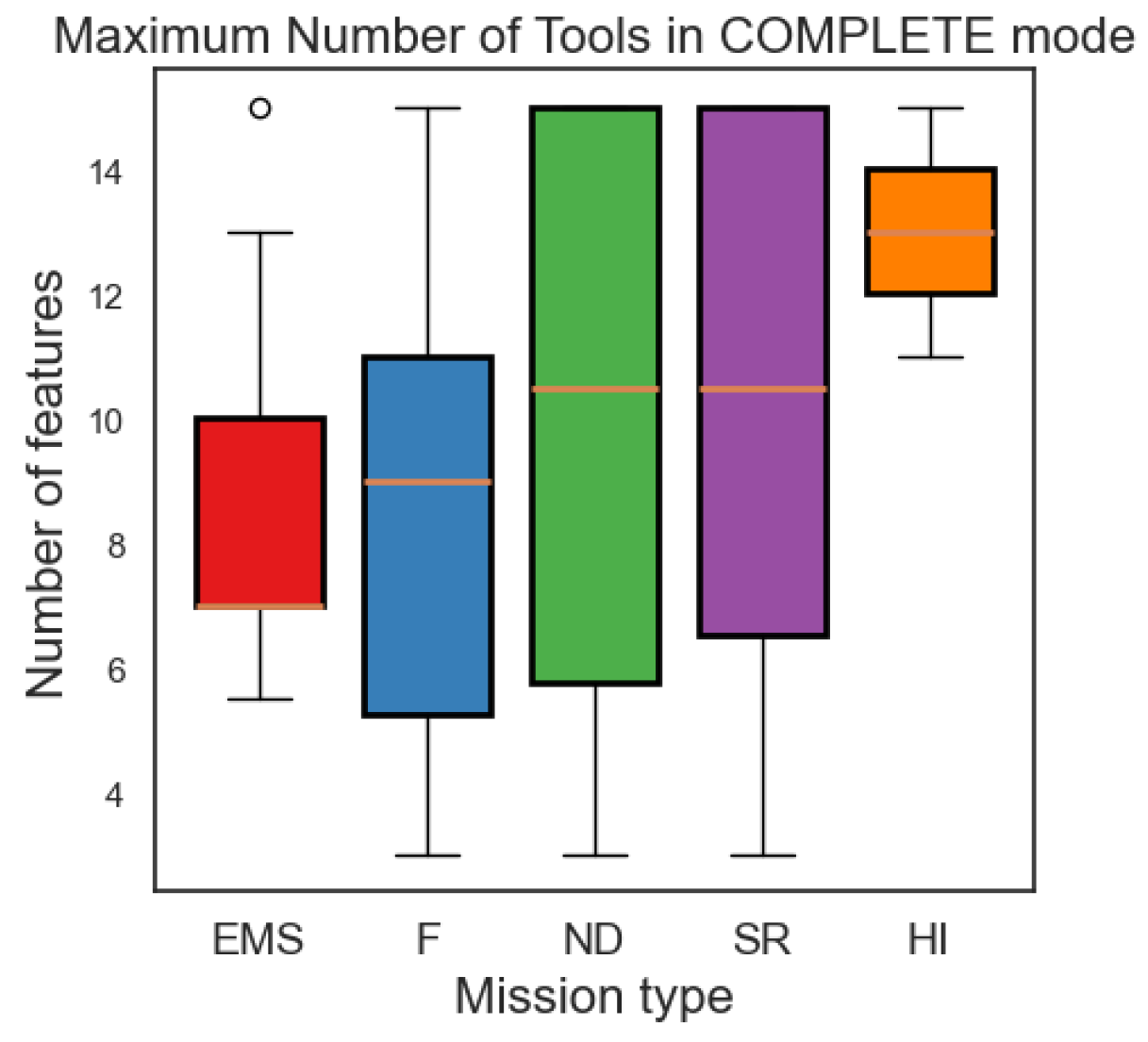
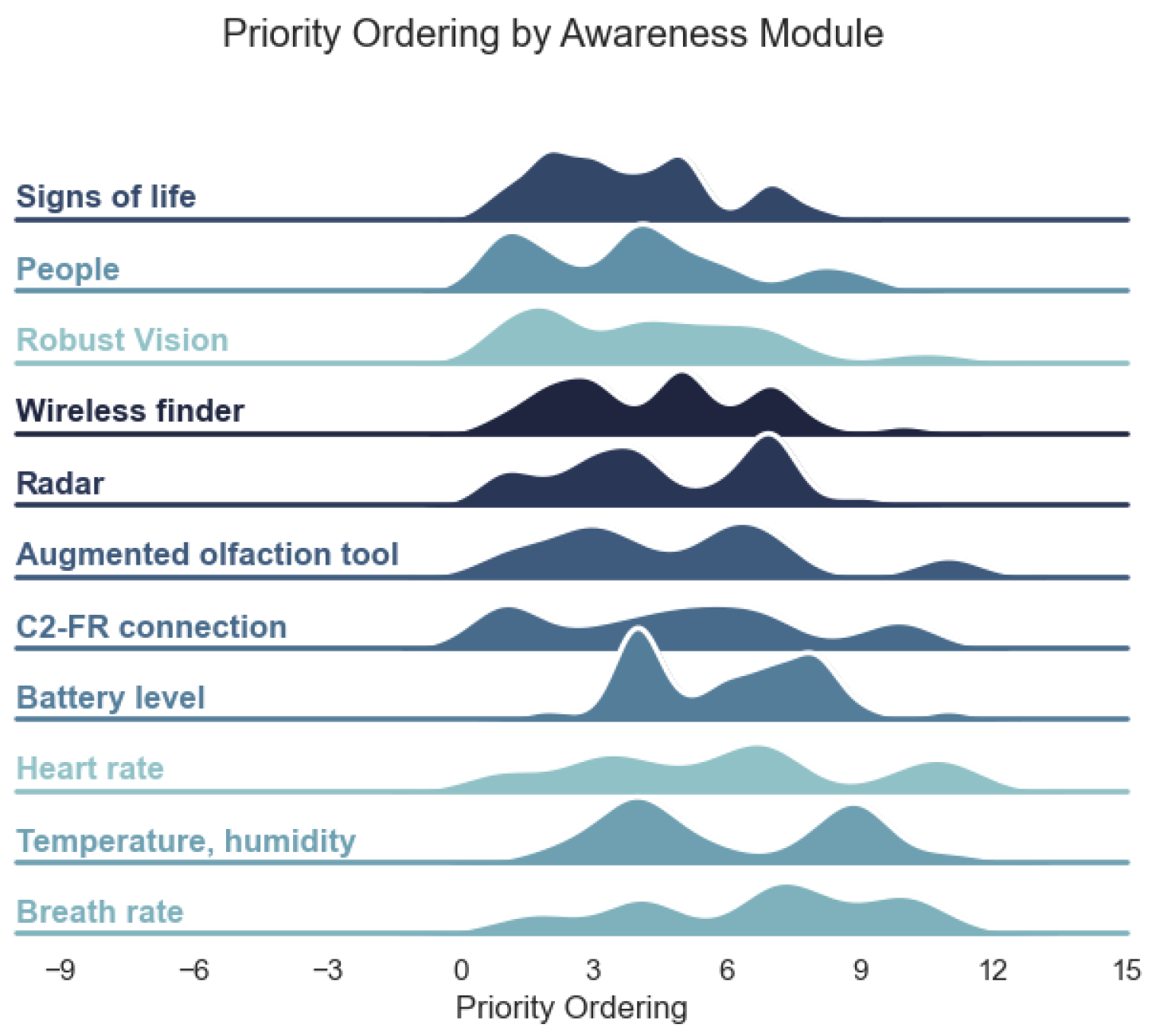
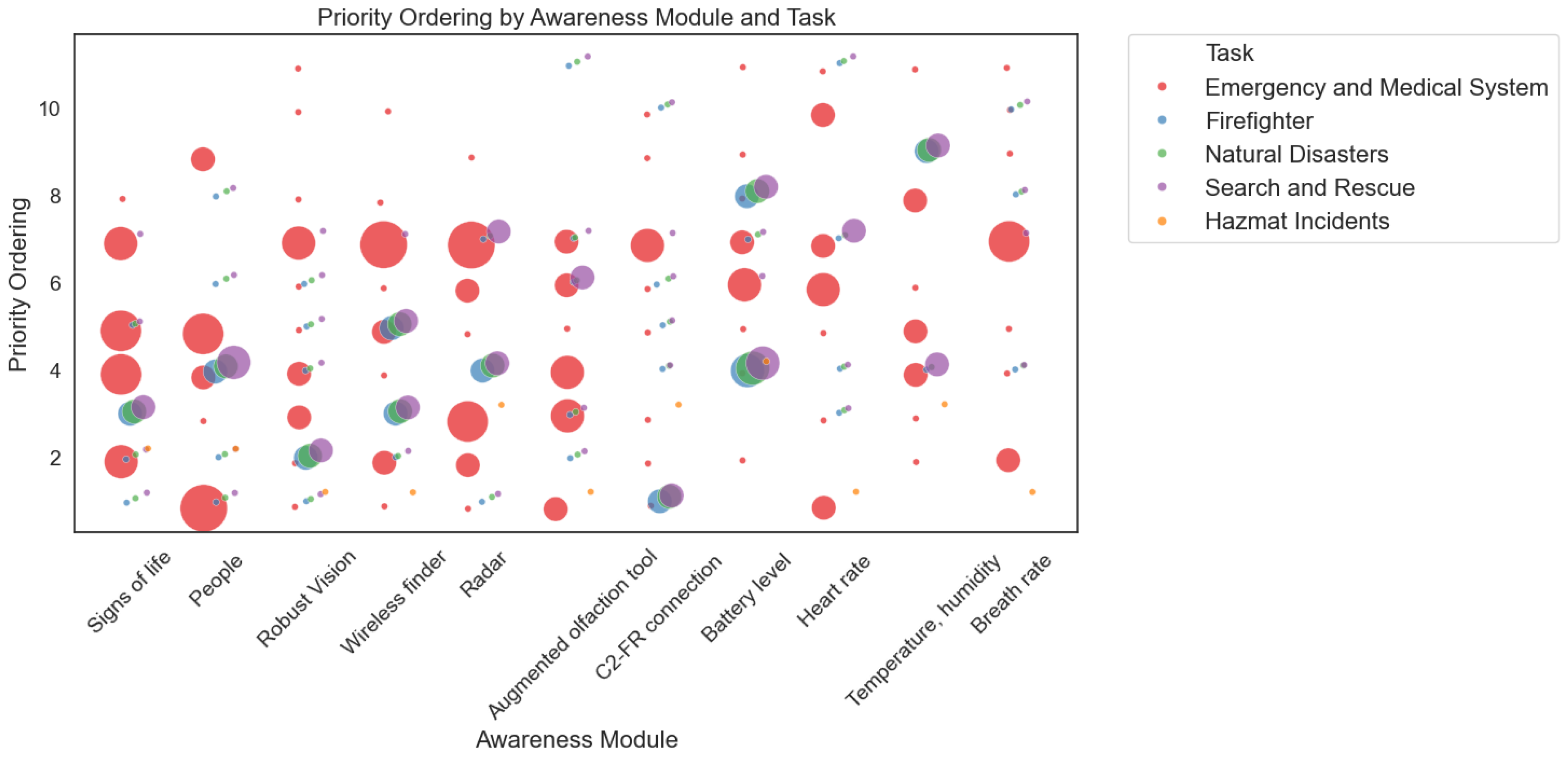

| Category | Number |
|---|---|
| Firefighter | 10 |
| Search and Rescue | 14 |
| Natural Disasters | 12 |
| Emergency and Medical System | 17 |
| Hazmat Incidents | 2 |
| Awareness Module | Mean | Std |
|---|---|---|
| Robust vision | 2.42 | 0.71 |
| Breath rate | 2.36 | 0.70 |
| Heart rate | 2.36 | 0.70 |
| Battery level | 2.33 | 0.61 |
| Radar | 2.31 | 0.74 |
| C2-FR connection | 2.29 | 0.76 |
| Augmented olfaction tool | 2.15 | 0.65 |
| People | 2.05 | 0.83 |
| Temperature, humidity | 2.05 | 0.80 |
| Signs of life | 2.00 | 0.84 |
| Wireless finder | 1.84 | 0.74 |
| Mission Type | Mean | Std |
|---|---|---|
| Emergency and Medical System (EMS) | 6.47 | 3.24 |
| Firefighter (F) | 5.35 | 1.80 |
| Natural Disasters (ND) | 5.96 | 3.35 |
| Search and Rescue (SR) | 6.46 | 3.39 |
| Hazmat Incidents (HI) | 9.50 | 7.78 |
| Awareness Module | Mean | Std |
|---|---|---|
| Heart rate | 3.47 | 2.71 |
| Radar | 3.71 | 2.48 |
| Breath rate | 4.08 | 2.33 |
| Augmented olfaction tool | 4.23 | 2.68 |
| Robust vision | 4.73 | 3.08 |
| Temperature, humidity | 4.88 | 2.78 |
| People | 4.96 | 2.97 |
| C2-FR connection | 5.03 | 2.90 |
| Signs of life | 5.19 | 2.88 |
| Battery level | 5.51 | 2.28 |
| Wireless finder | 7.00 | 3.14 |
| Awareness Module | Emergency and Medical System | Hazmat Incidents | Natural Disasters | Search and Rescue | Firefighter |
|---|---|---|---|---|---|
| Aug. olfaction tool | 3.07 | 1.0 | 5.40 | 5.00 | 6.25 |
| Battery level | 6.20 | 8.0 | 5.00 | 5.40 | 5.00 |
| Breath rate | 4.33 | 3.0 | 3.57 | 4.67 | 3.57 |
| C2-FR connection | 5.54 | 9.0 | 4.38 | 4.80 | 4.57 |
| Heart rate | 4.00 | 2.0 | 2.71 | 4.11 | 2.71 |
| People | 5.30 | 4.0 | 4.80 | 4.86 | 4.80 |
| Radar | 4.67 | 9.0 | 2.57 | 3.00 | 2.83 |
| Robust vision | 6.25 | 2.0 | 3.83 | 4.12 | 3.83 |
| Signs of life | 4.58 | 5.0 | 6.00 | 5.33 | 6.00 |
| Temp., humidity | 4.83 | 7.0 | 4.67 | 5.00 | 4.67 |
| Wireless finder | 7.00 | 6.0 | 7.50 | 6.50 | 7.50 |
| Awareness Module | Mean | Std |
|---|---|---|
| Signs of life | 2.76 | 0.43 |
| Robust vision | 2.69 | 0.57 |
| Wireless finder | 2.60 | 0.49 |
| Radar | 2.58 | 0.50 |
| People | 2.51 | 0.72 |
| C2-FR connection | 2.44 | 0.60 |
| Heart rate | 2.35 | 0.64 |
| Battery level | 2.33 | 0.47 |
| Breath rate | 2.29 | 0.63 |
| Augmented olfaction tool | 2.15 | 0.76 |
| Temperature, humidity | 2.15 | 0.62 |
| Mission Type | Mean | Std |
|---|---|---|
| Emergency and Medical System (EMS) | 9.26 | 4.27 |
| Firefighter (F) | 7.95 | 4.18 |
| Natural Disasters (ND) | 9.12 | 4.67 |
| Search and Rescue (SR) | 9.46 | 4.59 |
| Hazmat Incidents (HI) | 10.00 | 7.07 |
| Awareness Module | Mean | Std |
|---|---|---|
| People | 3.46 | 1.85 |
| Signs of life | 4.34 | 2.67 |
| Radar | 4.58 | 2.18 |
| Robust vision | 4.59 | 2.27 |
| Heart rate | 4.71 | 3.07 |
| C2-FR connection | 4.94 | 3.32 |
| Wireless finder | 5.34 | 2.79 |
| Breath rate | 5.50 | 2.81 |
| Augmented olfaction tool | 6.00 | 3.35 |
| Battery level | 6.30 | 1.96 |
| Temperature, humidity | 6.33 | 2.30 |
| Awareness Module | Hazmat Incidents | Emergency & Medical System | Search & Rescue | Firefighter | Natural Disasters |
|---|---|---|---|---|---|
| Aug. olfaction tool | 1.0 | 3.70 | 8.00 | 9.33 | 9.33 |
| Battery level | 8.0 | 6.56 | 6.00 | 6.00 | 6.00 |
| Breath rate | 5.0 | 6.00 | 5.33 | 4.50 | 4.50 |
| C2-FR connection | 6.0 | 6.18 | 4.43 | 4.00 | 4.00 |
| Heart rate | 5.0 | 5.70 | 4.25 | 3.33 | 3.33 |
| People | 2.0 | 3.67 | 3.38 | 3.43 | 3.43 |
| Radar | 3.0 | 4.92 | 4.57 | 4.33 | 4.33 |
| Robust vision | 2.0 | 5.50 | 4.43 | 4.00 | 4.00 |
| Signs of life | 2.0 | 4.67 | 4.43 | 4.17 | 4.17 |
| Temperature, humidity | 6.0 | 5.70 | 6.33 | 8.00 | 8.00 |
| Wireless finder | 1.0 | 5.92 | 5.29 | 5.17 | 5.17 |
| Awareness Module | Mean | Std |
|---|---|---|
| Robust vision | 2.89 | 0.31 |
| Signs of life | 2.73 | 0.56 |
| Wireless finder | 2.67 | 0.58 |
| Battery level | 2.62 | 0.59 |
| Radar | 2.56 | 0.60 |
| C2-FR connection | 2.55 | 0.60 |
| Augmented olfaction tool | 2.45 | 0.50 |
| People | 2.44 | 0.66 |
| Heart rate | 2.38 | 0.78 |
| Temperature, humidity | 2.35 | 0.64 |
| Breath rate | 2.31 | 0.79 |
| Mission Type | Mean | Std |
|---|---|---|
| Emergency and Medical System (EMS) | 8.03 | 2.44 |
| Firefighter (F) | 8.80 | 4.32 |
| Natural Disasters (NDs) | 9.83 | 4.59 |
| Search and Rescue (SR) | 10.07 | 4.48 |
| Hazmat Incidents (HIs) | 13.00 | 2.83 |
| Awareness Module | Mean | Std |
|---|---|---|
| Signs of life | 3.81 | 1.96 |
| People | 3.97 | 2.48 |
| Robust Vision | 4.29 | 2.63 |
| Wireless finder | 4.52 | 2.26 |
| Radar | 4.53 | 2.32 |
| Augmented olfaction tool | 4.93 | 2.85 |
| C2-FR connection | 4.93 | 3.04 |
| Battery level | 6.00 | 2.07 |
| Heart rate | 6.00 | 3.24 |
| Temperature, humidity | 6.14 | 2.71 |
| Breath rate | 6.59 | 2.94 |
| Awareness Module | Emergency and Medical System | Hazmat Incidents | Firefighter | Natural Disasters | Search and Rescue |
|---|---|---|---|---|---|
| Augmented olfaction tool | 4.15 | 1.0 | 5.80 | 5.80 | 5.83 |
| Battery level | 6.45 | 4.0 | 5.83 | 5.83 | 5.86 |
| Breath rate | 6.45 | 1.0 | 7.33 | 7.33 | 7.25 |
| C2-FR connection | 5.70 | 3.0 | 4.50 | 4.50 | 4.86 |
| Heart rate | 6.08 | 1.0 | 6.25 | 6.25 | 6.40 |
| People | 3.86 | 2.0 | 4.17 | 4.17 | 4.14 |
| Radar | 4.88 | 3.0 | 4.00 | 4.00 | 4.60 |
| Robust Vision | 5.57 | 1.0 | 3.33 | 3.33 | 3.86 |
| Signs of life | 4.73 | 2.0 | 2.80 | 2.80 | 3.50 |
| Temperature, humidity | 5.60 | 3.0 | 7.33 | 7.33 | 6.50 |
| Wireless finder | 5.57 | 1.0 | 3.60 | 3.60 | 4.17 |
| Question | Survival Scenario | Rescue Scenario | Complete Scenario |
|---|---|---|---|
| 1. How frequently should the following information appear? | - Most tools: “Only if anomaly” - Robust vision, Heart rate, Breath rate: “Constantly” - Wireless Finder, Black box info: “Never” | - Higher frequency than survival - Signs of life, Robust vision, Wireless finder: “Constantly” - Varied opinions on other tools | - Majority: “Constantly” - Augmented Olfaction, People, C2-FR Connection, Temp/Humidity: “Constantly” or “Only if anomaly” - Rare cases: “Never” |
| 2. Maximum number of functionalities visible at one time? | - Firefighters: 4–6 - Search and Rescue: 4–8 - EMS: 4–10 - Hazmat Incidents: 6 or 12 | - Generally higher than survival - Firefighters: 8 - Other tasks: 9–10 - Variability: 6–14 | - Around 9 on average - EMS: 8 - Hazmat Incidents: 13 - Other tasks: 8–10 |
| 3. Priority order of functionalities to be shown? | 1. Heart rate 2. Radar 3. Breath rate 4. Augmented olfaction tool … 11. Wireless finder | 1. People 2. Signs of life 3. Radar 4. Robust vision … 11. Temperature, humidity | 1. Signs of life 2. People 3. Robust vision 4. Wireless finder … 11. Breath rate |
| 4. What else would you add, remove, or change? | - No specific additions/removals mentioned. Focus on varied tools depending on tasks. | - Similar diversity in priorities - Augmented olfaction important for EMS and Hazmat, less so for others. | - Priority varies by task - EMS: People, Augmented olfaction - Hazmat: Augmented olfaction, Breath, Heart rate - General: Focus on victim detection |
Disclaimer/Publisher’s Note: The statements, opinions and data contained in all publications are solely those of the individual author(s) and contributor(s) and not of MDPI and/or the editor(s). MDPI and/or the editor(s) disclaim responsibility for any injury to people or property resulting from any ideas, methods, instructions or products referred to in the content. |
© 2024 by the authors. Licensee MDPI, Basel, Switzerland. This article is an open access article distributed under the terms and conditions of the Creative Commons Attribution (CC BY) license (https://creativecommons.org/licenses/by/4.0/).
Share and Cite
Azpiroz, I.; Olaizola, I.G.; Oregui, X.; García, A.F.; Ruiz, V.; Larraga-García, B.; Gutiérrez, Á. White Paper on Adaptive Situational Awareness Enhancing Augmented Reality Interface Design on First Responders in Rescue Tasks. Appl. Sci. 2024, 14, 8282. https://doi.org/10.3390/app14188282
Azpiroz I, Olaizola IG, Oregui X, García AF, Ruiz V, Larraga-García B, Gutiérrez Á. White Paper on Adaptive Situational Awareness Enhancing Augmented Reality Interface Design on First Responders in Rescue Tasks. Applied Sciences. 2024; 14(18):8282. https://doi.org/10.3390/app14188282
Chicago/Turabian StyleAzpiroz, Izar, Igor García Olaizola, Xabier Oregui, Anaida Fernández García, Verónica Ruiz, Blanca Larraga-García, and Álvaro Gutiérrez. 2024. "White Paper on Adaptive Situational Awareness Enhancing Augmented Reality Interface Design on First Responders in Rescue Tasks" Applied Sciences 14, no. 18: 8282. https://doi.org/10.3390/app14188282







